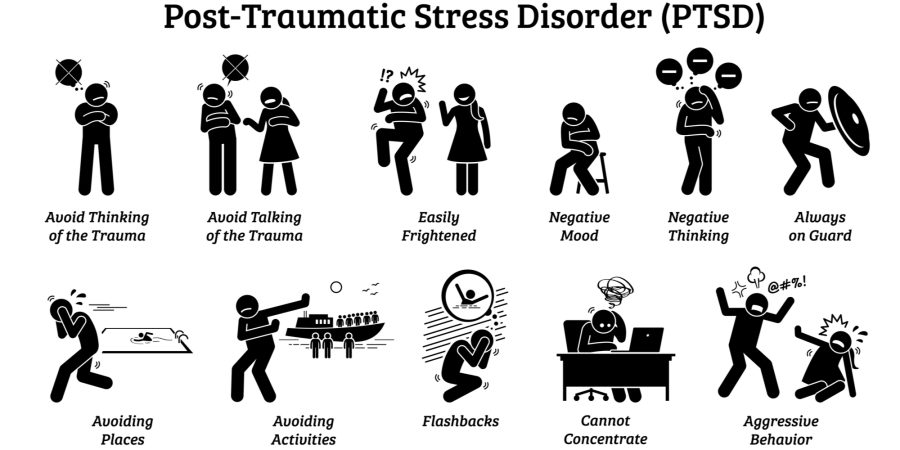
As a veteran, you are probably familiar with post-traumatic stress disorder (PTSD). But what exactly is complex post-traumatic stress disorder (CPTSD)?
This article will explain the differences between PTSD and CPTSD and how you can get help for this mental health issue.
Table of Contents
PTSD and Borderline Personality Disorder vs. CPTSD


Post-traumatic stress disorder is a mental health condition that can develop in people who have gone through traumatic experiences. This is an especially common disorder in veterans who have experienced combat. In fact, thousands of veterans are diagnosed with PTSD every year.
But complex post-traumatic stress disorder is a little different than the symptoms of PTSD you might be familiar with. This is because complex PTSD comes with additional symptoms of anxiety, depression, and addiction.
CPTSD occurs in people, including veterans, who have gone through multiple traumatic experiences. In people with complex PTSD, this condition often stems from childhood trauma and only worsens as a result of repeated trauma during war or other life stressors.
The American Psychological Association states that complex PTSD is “more extensive” or more complicated than typical post-traumatic stress disorder and its common symptoms.
Interestingly, research shows that up to half of veterans who meet the diagnosis requirements for post-traumatic stress disorder also meet the criteria for complex PTSD. This shows us that CPTSD is more common than we originally thought.
Additionally, complex post-traumatic stress disorder has often been confused with another mental health condition called borderline personality disorder (BPD). BPD typically stems from childhood trauma as well, including emotional, physical, and sexual abuse along with other traumatic experiences.
However, borderline personality disorder is different from CPTSD because borderline personality disorder typically presents four additional symptoms:
- Fear of abandonment
- Lack of self-awareness
- Impulsivity
- An inability to create healthy relationships with friends, family members, etc.
So now that you know some of the defining features that differentiate borderline personality disorder and complex post-traumatic stress disorder, how can you distinguish between the symptoms of PTSD and CPTSD?
We’ll explain the differences in symptoms below.
Symptoms of PTSD vs. CPTSD
The symptoms of PTSD might be what veterans feel are most familiar to them. PTSD is a panic disorder or anxiety disorder that can cause:
- Flashbacks to the traumatic event
- Nightmares and sleep difficulties
- Persistent anxiety
- Depression
- Mood and behavioral changes
- Avoiding situations that remind you of the traumatic event
As stated above, post-traumatic stress disorder (PTSD) happens commonly in veterans who have gone through a traumatic event, such as combat injury, sustained deployment, and witnessing bodily harm or death.
If you have been diagnosed with PTSD but you feel as though you are still struggling with the symptoms and the emotional pain of this mental health problem, you might have further traumas that you need to process to fully heal.
The main difference between PTSD and complex post-traumatic stress disorder involves the trauma itself.
In cases with repeated trauma, veterans are much more likely to develop CPTSD because they had traumatic experiences over a long period of time. This chronic trauma is incredibly hard to heal from and often leads veterans to unhealthy coping mechanisms, like substance abuse, to try to numb the emotional pain of reliving the traumas.
CPTSD comes with the same classic symptoms of PTSD that are explained above. However, they usually last for a longer period of time and sometimes they can be more severe and harder to treat.
Additional Symptoms of CPTSD


The additional symptoms of CPTSD include:
- Memory loss and forgetfulness of the traumas
- Self-esteem troubles
- Disassociation
- Drastic behavioral changes
- Irrational patterns of thinking
- Inability to control or regulate emotions
It’s important to remember that your brain has a distinct way of protecting itself from traumatic experiences. Mood and behavioral changes, memory loss, and negative self-talk are all normal reactions in people with complex PTSD.
Many people with complex PTSD also feel that they are worthless or will try anything to avoid the pain of reliving their traumas. This is often where addiction and complex PTSD intertwine.
Though turning to drugs and alcohol might feel like the easiest way of dealing with your mental health conditions, these are not healthy solutions to healing from trauma. Instead, addiction will simply lead to more pain down the road.
That being said, treatment for CPTSD can help you to improve your quality of life and feel like yourself again.
Treatment for People with Complex PTSD
Treatment for CPTSD has come a long way in recent years. Currently, the United States Department of Veterans Affairs encourages veterans to find a mental health professional to truly begin to heal from the experienced traumas.
Therapies such as cognitive behavioral therapy or cognitive processing therapy can be extremely helpful for people with complex PTSD.
Moreover, there is a unique therapy for people with complex PTSD. This therapy is called eye movement desensitization and reprocessing (EMDR). According to the Eye Movement Desensitization and Reprocessing Institute, EMDR therapy has been effective in helping nearly 80 percent of veterans diagnosed with PTSD heal from their traumatic experiences in only a dozen sessions.
These statistics might seem exaggerated or you might feel that it would take a miracle to cure your PTSD. But there’s a science behind EMDR.
Here’s how EMDR works:
- With EMDR, you would work one-on-one with a mental health professional to go over your traumatic memories.
- The mental health professional will ask you to walk them through a specific traumatic experience (one at a time and per session until all or most traumatic memories have been addressed).
- While you are speaking about the traumatic memories, the mental health professional will have you follow either their hand, light, or another object with your eyes.
- This helps you to physiologically reprocess and recover from your traumatic memories in a safe space. This healing comes on an emotional and physical level, allowing all parts of your body to recover from painful, traumatic experiences.
EMDR is a great and effective therapeutic approach for people with CPTSD—especially if you are a person with CPTSD who would like to recover from traumatic experiences as well as struggles with substance abuse disorders.
CPTSD and Addiction Recovery at Heroes’ Mile
At Heroes’ Mile, we work with veterans just like you who have experienced trauma and would like to find healing and peace through recovery.
We offer top-of-the-line addiction treatment for people with CPTSD and we truly believe in giving the best possible care to all of our veterans.
For more information on how we approach CPTSD and addiction, and to learn how we have your back in your recovery process, reach out to us by phone at 1-888-838-6692 or fill out our confidential online form today.
The post Complex PTSD: Symptoms and Treatments for Veterans appeared first on Heroes’ Mile Veterans Recovery Center.
Source
Original Author: Heroes’ Mile

